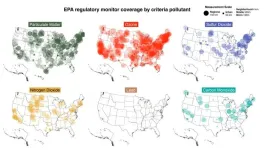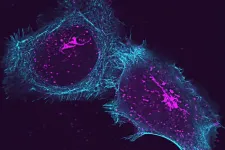(Press-News.org) A new study by UCLA Health has discovered what researchers say is the first drug to fully reproduce the effects of physical stroke rehabilitation in model mice, following from human studies.
The findings, published in Nature Communications, tested two candidate drugs derived from their studies on the mechanism of the brain effects of rehabilitation, of which one resulted in significant recovery in movement control after stroke in the mouse model.
Stroke is the leading cause of adult disability because most patients do not fully recover from the effects of stroke. There are no drugs in the field of stroke recovery, requiring stroke patients to undergo physical rehabilitation which has shown to be only modestly effective.
“The goal is to have a medicine that stroke patients can take that produces the effects of rehabilitation,” said Dr. S. Thomas Carmichael, the study’s lead author and professor and chair of UCLA Neurology. “Rehabilitation after stroke is limited in its actual effects because most patients cannot sustain the rehab intensity needed for stroke recovery.
“Further, stroke recovery is not like most other fields of medicine, where drugs are available that treat the disease—such as cardiology, infectious disease or cancer,” Carmichael said. “Rehabilitation is a physical medicine approach that has been around for decades; we need to move rehabilitation into an era of molecular medicine.”
In the study, Carmichael and his team sought to determine how physical rehabilitation improved brain function after a stroke and whether they could generate a drug that could produce these same effects.
Working in laboratory mice models of stroke and with stroke patients, the UCLA researchers identified a loss of brain connections that stroke produces that are remote from the site of the stroke damage. Brain cells that are located at a distance from the stroke site get disconnected from other neurons. As a result, brain networks do not fire together for such things like movement and gait.
The UCLA team found that some of the connections that are lost after stroke occur in a cell called a parvalbumin neuron. This type of neuron helps generate a brain rhythm, termed a gamma oscillation, which links neurons together so that they form coordinated networks to produce a behavior, such as movement. Stroke causes the brain to lose gamma oscillations. Successful rehabilitation in both laboratory mice and in humans brought gamma oscillations back into the brain, and in the mouse model, repaired the lost connections of parvalbumin neurons.
Carmichael and team then identified two candidate drugs that might produce gamma oscillations after stroke. These drugs specifically work to excite parvalbumin neurons. The researchers found one of the drugs, DDL-920, developed in the UCLA lab of Dr. Varghese John, who coauthored the study, produced significant recovery in movement control.
Further studies are needed to understand the safety and efficacy of this drug before it could be considered for human trials.
END
UCLA discovers first stroke rehabilitation drug to repair brain damage
Drug replicated recovery of the movement control produced by rehab in mice
2025-03-18
ELSE PRESS RELEASES FROM THIS DATE:
Only around 1 in 10 common non-surgical and non-invasive treatments for back pain effective
2025-03-18
Only around 1 in 10 common non-surgical and non-invasive treatments for lower back pain is effective, suggests a pooled data analysis of the available research, published online in BMJ Evidence Based Medicine.
And the pain relief they offer is only marginally better than that achieved with a placebo, the findings indicate.
Low back pain is common and debilitating, and 80%-90% of it is categorised as non-specific, because there’s no immediately identifiable cause, note the researchers.
Non-surgical and non-invasive ...
Installing safety nets on Golden Gate Bridge linked to 73% decline in suicides
2025-03-18
Early evidence indicates that the installation of safety nets on the Golden Gate Bridge in San Francisco has been successful in reducing the number of suicides at the bridge.
The results, published online in the journal Injury Prevention, show a 73% decline in suicides in the 12 months since the nets were completed relative to the number before net installation began.
The researchers say their findings “highlight the value of installing nets on this bridge and the importance of barriers as a strategy to prevent suicides by jumping.”
The ...
Increasing fruit, fiber, dairy and caffeine linked to lower risk of tinnitus
2025-03-18
Increased consumption of fruit, dietary fibre, dairy products and caffeine may be associated with a reduced risk of tinnitus (ringing in the ears), suggests an analysis of the available evidence, published in the open access journal BMJ Open.
The researchers stress that their findings can’t establish a direct (causal) relationship and should be interpreted with care because of the low quality of the evidence. But they say possible reasons may involve the protective effects of these diets on blood vessels and nerves, as well as their anti-inflammatory ...
Does BMI become useless as we age?
2025-03-18
Body mass index (BMI) is key method for measuring a person’s weight status, and defining if they have normal weight, overweight, or obesity. However, new research to be presented at this year’s European Congress on Obesity (ECO 2025, Malaga, Spain, 11-14 May) shows that people with obesity at similar BMIs display significant differences in body composition in different body compartments according to their age group, such as higher body fat especially in central regions and lower muscle mass ...
Rice statistician earns $1 million CPRIT award to advance AI-powered precision medicine for prostate cancer
2025-03-18
HOUSTON – (March 18, 2025) – Erzsébet Merényi, a statistics research professor at Rice University, and co-investigators at The University of Texas MD Anderson Cancer Center Pratip Bhattacharya, professor of cancer systems imaging, and Dr. Patrick Pilié, assistant professor of genitourinary medical oncology, were awarded $1 million by the Cancer Prevention and Research Institute of Texas (CPRIT) to develop artificial intelligence (AI) tools that can identify lethal forms of prostate cancer earlier and improve treatment selection.
Prostate cancer ...
Whose air quality are we monitoring?
2025-03-18
U.S. Environmental Protection Agency (EPA) air quality monitors are disproportionally located in predominately white neighborhoods, according to University of Utah research. The EPA’s network consistently failed to capture air quality in communities of color across six major pollutants, particularly lead and sulfur dioxide, followed by ozone and carbon monoxide.
EPA regulatory monitors are the key data source driving decisions about pollution reduction, urban planning and public health initiatives. Without equal monitor distribution, the data may misrepresent pollution concentrations, leaving marginalized groups at risk.
“It’s ...
Team Hope rides (again) for cancer research at the Tour de Scottsdale
2025-03-18
For the second year in a row, Mayo Clinic physician Dr. Parminder Singh has organized a team of riders to raise funds for cancer research while tackling the 32- or 62-mile routes of the Tour de Scottsdale.
Singh is a clinical trialist with SWOG Cancer Research Network, a world-renowned organization leading cancer studies across the US and beyond. SWOG trials have led to the approval of 14 cancer drugs, changed more than 100 standards of cancer care, and saved more than 3 million years of human life.
Team Hope’s youngest rider is 11-year-old Misha Rajpal who will take on the full, ...
Researchers find missing link in autoimmune disorder
2025-03-18
Autoimmune diseases, which are estimated to affect more than 15 million people in the U.S., occur when the body responds to immune-system false alarms, and infection-fighting first responders are sent out to attack threats that aren’t there. Scientists have long understood how the false alarms get triggered, but the second step of dispatching the immune response has been a mystery.
Now, scientists at Washington University School of Medicine in St. Louis and the Perelman School of Medicine at the University of Pennsylvania ...
‘Democratizing chemical analysis’: FSU chemists use machine learning and robotics to identify chemical compositions from images
2025-03-18
TALLAHASSEE, Fla. — Florida State University chemists have created a machine learning tool that can identify the chemical composition of dried salt solutions from an image with 99% accuracy.
By using robotics to prepare thousands of samples and artificial intelligence to analyze their data, they created a simple, inexpensive tool that could expand possibilities for performing chemical analysis. The work was published in Digital Discovery.
“We are living in the age of artificial intelligence and big data,” ...
Leveraging data science for disease prediction in the fight against rheumatoid arthritis
2025-03-18
Fan Zhang, PhD, sees artificial intelligence as a pathway to finding an effective way to combat an intractable enemy: rheumatoid arthritis.
Zhang is an assistant professor in the University of Colorado Department of Medicine’s Division of Rheumatology and also is affiliated with the Department of Biomedical Informatics on the CU Anschutz Medical Campus. She recently received a highly competitive grant from the Arthritis Foundation to further her work in harnessing AI to better predict the onset of rheumatoid arthritis (RA) in particular patients, ...
LAST 30 PRESS RELEASES:
When is it time to jump? The boiling frog problem of AI use in physics education
Twitter data reveals partisan divide in understanding why pollen season's getting worse
AI is quick but risky for updating old software
Revolutionizing biosecurity: new multi-omics framework to transform invasive species management
From ancient herb to modern medicine: new review unveils the multi-targeted healing potential of Borago officinalis
Building a global scientific community: Biological Diversity Journal announces dual recruitment of Editorial Board and Youth Editorial Board members
Microbes that break down antibiotics help protect ecosystems under drug pollution
Smart biochar that remembers pollutants offers a new way to clean water and recycle biomass
Rice genes matter more than domestication in shaping plant microbiomes
Ticking time bomb: Some farmers report as many as 70 tick encounters over a 6-month period
Turning garden and crop waste into plastics
Scientists discover ‘platypus galaxies’ in the early universe
Seeing thyroid cancer in a new light: when AI meets label-free imaging in the operating room
Neutrophil-to-lymphocyte ratio may aid risk stratification in depressive disorder
2026 Seismological Society of America Annual Meeting
AI-powered ECG analysis offers promising path for early detection of chronic obstructive pulmonary disease, says Mount Sinai researchers
GIMM uncovers flaws in lab-grown heart cells and paves the way for improved treatments
Cracking the evolutionary code of sleep
Medications could help the aging brain cope with surgery, memory impairment
Back pain linked to worse sleep years later in men over 65, according to study
CDC urges ‘shared decision-making’ on some childhood vaccines; many unclear about what that means
New research finds that an ‘equal treatment’ approach to economic opportunity advertising can backfire
Researchers create shape-shifting, self-navigating microparticles
Science army mobilizes to map US soil microbiome
Researchers develop new tools to turn grain crops into biosensors
Do supervised consumption sites bring increased crime? Study suggests that’s a myth
New mass spec innovation could transform research
Maternal nativity, race, and ethnicity and infant mortality in the US
Migration-related trauma among asylum seekers exposed to the migrant protection protocols
Jupiter’s moon Europa has a seafloor that may be quiet and lifeless
[Press-News.org] UCLA discovers first stroke rehabilitation drug to repair brain damageDrug replicated recovery of the movement control produced by rehab in mice


